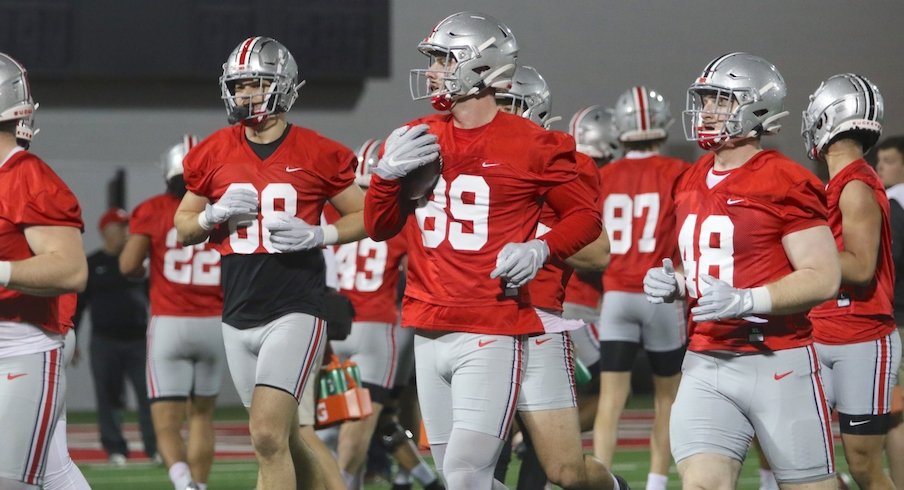Luke Farrell, a fifth-year senior tight end and possible team captain, tilted his head back and smirked as he shrugged.
The question of whether this will be the year Ohio State finally starts throwing the ball to those in his position group with more regularity was once again posed to him. Any tight end who has come through the football program in recent years has heard it asked somewhere between 20 and 30 million times.
“I get that question a lot, and a lot of times it comes from people who don't fully understand the position, which is hard to,” Farrell said in early March.
As both Farrell and Kevin Wilson often say, tight ends get asked to do a heck of a lot more than run routes and catch passes. Most of the time they’re on the field, they’re blocking, and oftentimes they’re at a size disadvantage when taking on defensive linemen or trying to block an agile linebacker in open space.
Their jobs aren’t particularly easy, yet they also don’t get much notoriety from the public when they’re doing anything other than making receptions.
“What are you doing those other plays?” Wilson said on March 4. “They've still got to be great players without the ball.”
Farrell added: “We take pride in that.”
During the plays when he isn’t running routes, Farrell has already become a steady blocker. The coaches graded him out as a “champion” for nine regular-season games. Jeremy Ruckert also made notable strides as a blocker, which was the area he needed to progress furthest in when he arrived at Ohio State in 2018.
To Wilson, a tight end’s ability to block matters as much as anything else.
But it’s also fair to wonder whether or not they can get more targets, even if it isn’t the type of breakthrough anyone still holding out hope for a tight end-heavy passing game is envisioning.
Ruckert, once a near-five-star prospect largely due to his receiving acumen, managed 14 catches for 142 yards and four touchdowns in 404 snaps. Playing a tight end high of 459 snaps, Farrell caught seven passes for 119 yards and two touchdowns. Jake Hausmann two catches for 13 yards and a touchdown in 235 snaps. As a position group, the tight ends accounted for only 26 of the team’s 271 receptions despite playing a combined 1,430 offensive snaps, including more multi-tight end sets than in recent years.
To get more catches going forward, Wilson said, they need to show Ryan Day and Justin Fields that they are “deserving” of more targets than the other potential pass-catchers – namely, the wide receivers. To make that happen, he believes, it’ll come down to speed.
“When I watched us play last year, I thought we played well, but I didn't think we played as fast as they all can,” Wilson said.
This offseason, Ohio State’s tight ends have spent a good deal of time watching how NFL teams put the position to use.
Together, they’ve watched the San Francisco 49ers, who employed George Kittle for an 85-catch, 1,053-yard, five-touchdown performance last year. Fullback Kyle Juszczyk (20 catches, 239 yards, 1 touchdown) and tight end Ross Dwelley (15 catches, 91 yards, 2 touchdowns) also made impacts.
They turned on some film of the Baltimore Ravens to see the trio of Mark Andrews (64 catches, 852 yards, 10 touchdowns), Hayden Hurst (30 catches, 349 yards, 2 touchdowns) and Nick Boyle (31 catches, 321 yards, 2 touchdowns). The tight ends also watched some tape of the Carolina Panthers, who relied on Greg Olsen (52 catches, 597 yards, 2 touchdowns) and Ian Thomas (16 catches, 136 yards, 1 touchdown).
“Their guys are really versatile, and we think that our guys can do kind of the same stuff,” Ruckert said. “With coach Wilson, coach (Tim) Hinton, just watching how they scheme up the run plays, how they play with the speed they play at. We're kind of just studying them right now.”
Having spent so much time across the landscape of football, Wilson was already familiar with many of the tight ends the Buckeyes dissected.
While he was coaching the Sooners, he got to see Kittle star for Norman High School in Norman, Oklahoma. As Indiana’s head coach, he landed Thomas from a New York junior college.
For Wilson, both the first-hand experience and the film showed that Ohio State’s receivers can play at the speed of NFL veterans.
“I'm watching these guys play, and I go, ‘I know how fast these guys are. You're as fast or faster than them. I want to see this on tape more.’ So our goal these first two days without pads is we wanted to play faster and feel speed and feel size,” Wilson said. “It'll be interesting. If we get the ball, as big as we are, if we start playing fast, I think you'll see the ball in their hands. That's just a confidence, knowledge deal. Sometimes it's physical development. But sometimes it's just more knowledge and cutting it loose and rolling.”
After losing three senior wide receivers with starting experience, including the program’s all-time receptions leader in K.J. Hill, Day will be on the lookout for a few players to get significant increases in targets in 2020. That could lead to some of the remarkably talented underclassman wideouts carving out significant roles early in their respective careers.
It also, though, opens up potential opportunities receiving opportunities for Farrell and Ruckert, who are looking to wedge their way further into the passing plans.
“If they're catching and they're running well, we'll see,” Wilson said.


